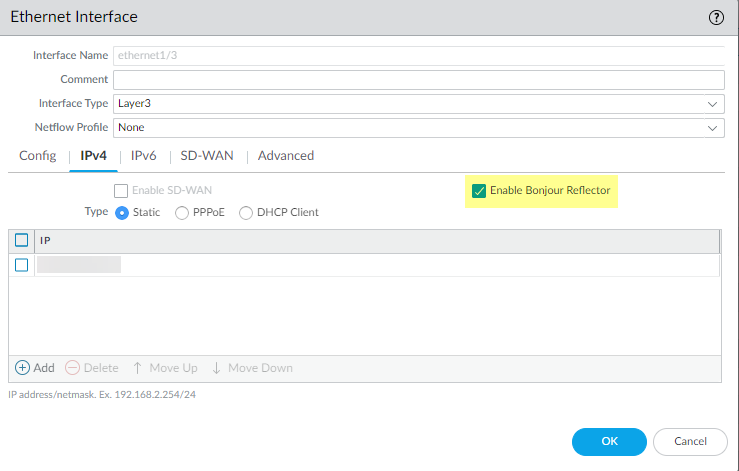Bonjour Reflector for Network Segmentation
Table of Contents
10.0 (EoL)
Expand all | Collapse all
-
- Automatic Content Updates Through Offline Panorama
- Enhanced Authentication for Dedicated Log Collectors and WildFire Appliances
- Syslog Forwarding Using Ethernet Interfaces
- Increased Configuration Size for Panorama
- Access Domain Enhancements for Multi-Tenancy
- Enhanced Performance for Panorama Query and Reporting
- Log Query Debugging
- Configurable Key Limits in Scheduled Reports
- Multiple Plugin Support for Panorama
End-of-Life (EoL)
Bonjour Reflector for Network Segmentation
Apple Bonjour (also known as zero-configuration
networking) enables automatic discovery of devices and services
on a local network. For example, Bonjour allows you to connect to
a printer without manually configuring the printer’s IP address.
To translate names to addresses on a local network, Bonjour uses
Multicast DNS (mDNS). Bonjour uses a private multicast range for
its traffic, which does not allow traffic routing, preventing use
in an environment that uses network segmentation for security or
administrative purposes (for example, where servers and clients
are in different subnets).
To support Apple Bonjour in network
environments that use segmentation to route traffic, you can now
forward Bonjour IPv4 traffic between Layer 3 (L3) Ethernet or Aggregated
Ethernet (AE) interfaces or subinterfaces that you specify. The
Bonjour Reflector option allows you to forward multicast Bonjour
advertisements and queries to L3 Ethernet and AE interfaces or subinterfaces,
ensuring user access to services and device discoverability regardless
of Time To Live (TTL) values or hop limitations.
Bonjour
traffic forwarding is supported for the PA-220, PA-800, and PA-3200
series.
When you enable this option, the firewall redirects
Bonjour traffic to the L3 and AE interfaces and subinterfaces where
you enable this option. You must enable this option on all supported interfaces
that you want to manage Bonjour traffic; for example, if you want
a specific L3 interface to forward Bonjour traffic to an AE interface,
you must enable this option on both interfaces. You can enable this
option on up to 16 interfaces.
To prevent loops, the firewall
modifies the source MAC address to the firewall’s egress interface
MAC address. To help prevent flooding attacks, if the firewall receives
more than the number of packets per second specified in the following
table, the firewall drops the packets to protect the firewall and
the network.
| Series | Rate Limit (per second) |
|---|---|
| PA-220 | 100 |
| PA-800 | 200 |
| PA-3200 | 500 |
- Select NetworkInterfaces.Select or Add an L3 ethernet or subinterface or AE interface.If you add a subinterface, it must use a Tag other than 0.Select IPv4 then select the Enable Bonjour Reflector option.
![]() Click OK.Repeat steps 1—4 for all L3 or AE interfaces and subinterfaces where you want to forward Bonjour traffic.You can enable this option on up to 16 different interfaces or subinterfaces.Commit your changes.Confirm that the Features column for the interface or interfaces where you enable the Bonjour Reflector option displays Bonjour Reflector:yes ().
Click OK.Repeat steps 1—4 for all L3 or AE interfaces and subinterfaces where you want to forward Bonjour traffic.You can enable this option on up to 16 different interfaces or subinterfaces.Commit your changes.Confirm that the Features column for the interface or interfaces where you enable the Bonjour Reflector option displays Bonjour Reflector:yes ().![]() Use the show bonjour interface CLI command to display all interfaces where the firewall forwards Bonjour traffic and a list of counters. rx represents the total number of Bonjour packets the interface receives, tx represents the total number of Bonjour packets the interface transmits, and drop represents the number of packets the interface drops.
Use the show bonjour interface CLI command to display all interfaces where the firewall forwards Bonjour traffic and a list of counters. rx represents the total number of Bonjour packets the interface receives, tx represents the total number of Bonjour packets the interface transmits, and drop represents the number of packets the interface drops.admin> show bonjour interface name rx tx drop ---------------------------------------------------------- ethernet1/4 1 1 0 ethernet1/7 0 0 0 ethernet1/7.10 0 0 0 ethernet1/7.20 4 4 0 ae15 0 0 0 ae16 0 0 0 ae16.30 0 2 0 ae16.40 0 0 0

